 Getting a job in innovation consulting is tricky.
Getting a job in innovation consulting is tricky.
Innovation consultancies are very selective, and there aren’t many roles.
To help you get a job as an innovation consultant, I have organised what you need to do in seven steps to share a lot of top tips.
In this article, I answer these good questions.
1. Understand the innovation space
First, you need to have a clear understanding of what innovation consulting means.
What’s innovation consulting all about?
Innovation consulting is the practice of helping organisations spot new opportunities and create new products, brands, and/or businesses.
Read more: If you’re interested in joining the space, I encourage you to read my reflections on what innovation consulting is all about.
Who tends to work in innovation consulting
Due to the complex nature of innovation, this type of consulting is at the cross-road of many disciplines:
- Economics
- Psychology
- Design
- Marketing
- Anthropology
- Sociology
- Engineering
As a consequence, innovation consultants tend to have very different backgrounds.

You can see consultants who were lawyers, who studied business and administration, who are engineers, who worked in advertising, or who use to be entrepreneurs. Actually, innovation consultancies welcome a diversity of thinking. They welcome hiring people with less traditional backgrounds.
One thing though:
By definition, innovation is about dealing with the unknown.
It’s not about following a manual. It’s about exploring things that haven’t been done yet. So, the projects you’ll work on will require you to be curious, resourceful, and comfortable with not having answers to all the questions and challenges you’ll be facing.
Note: Your background matters less than you curiosity and your ability to deal with the unknown.
A creative or analytical job?
What do you think? An innovation consultant is more creative or analytical?
So?
Here’s a myth:
“Innovation consulting is all about having great ideas.”
It is a creative job—no doubt. But having ideas is just a small part of the job. Innovation consulting is also very analytical. And the key here is being able to balance both creativity and analysis.
- There are moments when you need to be creative (e.g., to generate new ideas) and,
- Other moments when you need to be more analytical (e.g., to generate insight from large datasets).
These are two types of skills that tend to be considered as “soft skills” and “hard skills”. And in practice, every innovation consultant needs to master both.

Remember: Innovation consultants are both creative and analytical, and they can quickly switch from one mode to the other.
Step 1: Do you research, and get a better understanding of what innovation consulting is all about. Here’s a starter with my reflections on this.
You can also have a look at The Opportunity Lenses. There, you’ll find more examples of how companies identify new business opportunities.
2. Map the consultancies you want to work for
Now, you want to find the innovation consultancies you want to work with.
But know that not every innovation consulting firm is the same.
There are a few elements that set them apart, including:
- Their size
- Countries where they have offices
- Their areas of expertise
- Industries they focus on
- The clients they work with
The size of the consultancy is maybe the most important differentiator. Working for a smaller firm will feel very different compared to working with a larger one.
Make sure to have those elements in mind when you select the companies you want to work with.
Some innovation consultancies
Let me list a few leading global firms here.
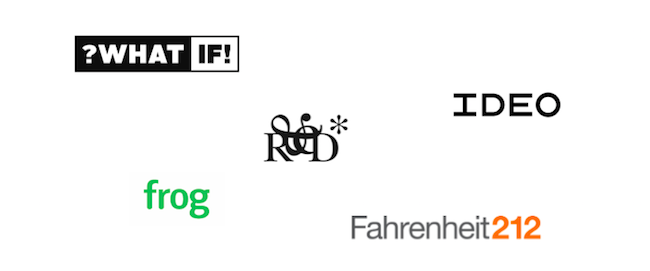
You can find more innovation consultancies by doing some research on Google and LinkedIn.
?What If!
?What If! uses an experimentation-based approach to crack innovation challenges and help its clients build new sources of revenue.
Originally started in the UK, the company has two big offices in New York and London (with lots of work in Europe) and a smaller one in Shanghai.
One book to read: The Science of Serendipity by Matt Kingdon
Network: Accenture (American tech consulting company)
(If you read the blog frequently, you may know that I have been running innovation projects at ?What If! for more than five years.)
IDEO
IDEO leans more towards design with strong focus on product innovation. They’re known for having popularised the design thinking methodology.
Originally from the US, the company has a strong American presence and smaller offices in Europe.
One book to read: Creative Confidence by Tom and David Kelley
Network: Kyu (Japanese creative collective)
ReD Associates
ReD Associates tends to focus more on insight and market research to inform strategic decisions. They make a real emphasis on sociology and ethnographic studies.
Originally from Denmark, the company is also present in the US.
One book to read: The Moment of Clarity by Christian Madsbjerg
Network: Cognizant (American tech consulting firm)
Frog Design
Frog Design also uses design as a catalyst for innovation.
Originally from the US, the company has offices in Europe and Asia.
Two books to read: A Fine Line by Hartmut Esslinger and How to Kill a Unicorn by Mark Payne
Network: Capgemini (French tech consulting company)
Note that Farenheit212 merged with Frog Design. Farenheit212 was used to be known for following a process that distinguishes between “magic” (insight and creativity) and “money” (business strategy).
Farenheit212
Farenheit212 follows a process with the distinction between “magic” (insight and creativity) and “money” (business strategy), where consultants specialise in one or the other bucket.
Originally from the US, the company has a big office in New York and a smaller one in London (with lots of work in Europe).
One book to read: How to Kill a Unicorn by Mark Payne
Network: Capgemini (French tech consulting company)
Selecting the right companies
As you Make sure you apply to firms that fit with who you are, what you want to be working on, and where you want to be after.
Jan Chipchase, author of The Field Study Handbook, listed 100 questions you should ask yourself or your future employer. It’s worth reading for inspiration.
Step 2: Make a spreadsheet with all the innovation consultancies you could work with (based on where their offices are located and recruitment policies).
You can use this list of some of the top innovation consulting firms to help start your research.
Then, select the ones you want to work with (according to size, type of work, industry focus, and clients).
3. Build your portfolio
Here’s something important to know:
Innovation consulting firms hire doers–someone who is fueled by an entrepreneurial spirit and likes making things happen.
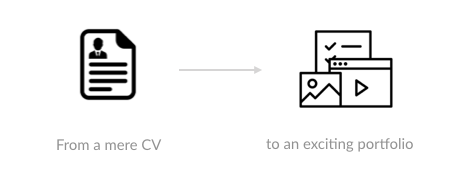
What’s the best way to show that?
Demonstrate that you’ve been running projects and delivering meaningful work.
I call this the Portfolio Mindset.
It’s not about the job titles you had. It’s about the work you’ve been delivering—your impact in the world.

Designers use portfolio to illustrate what they are capable of. It’s an effective way for them to show the results of their work.
The Muse puts it well:
“Working in a role where your product isn’t visual—like sales, product management, and the like—shouldn’t keep you from having a portfolio to show off your stuff. You just have to think a little more creatively.”
As an innovation consultant, you should be able to do the same. Show that you’ve run projects that have delivered something meaningful.
This is how you’ll stand out.
How to design your portfolio as an innovation consultant
An innovation consultant, you need to be able to make things real, i.e., illustrate visually abstract elements such as ideas or processes.
Here’s what I recommend to create your portfolio:
- Build a portfolio of case studies
- Add visual elements to your case studies
Doing this will help you convey your messages much more powerfully.
Build a portfolio of case studies
Choose the projects you’re the most proud of. This can be an entrepreneurial project, a side project, something you did in a previous job, or some volunteering.
And explain:
- The backstory: What was the context?
- The process: How did you go about it? What was your role?
- The output of your projects: What were the impact and the results?
As you can see, the case studies turn activities into projects.
Add visual elements to your case studies
Illustrate the process and results with photos, drawings, or mock-ups.
Are there any visual elements you can share that would make the impact of your work look more real?
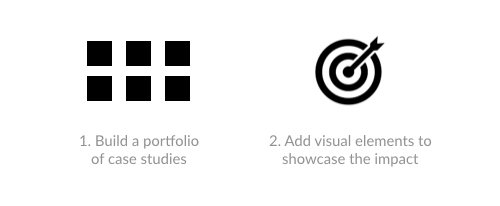
Being able to demonstrate the impact and results will increase your ability to impress your future employer. If you can’t use any visuals, you could also use quotes or numbers to illustrate what you did and the output of your work.
Step 3: Gather all the things you’ve and built to create your portfolio.If you feel that your portfolio is a bit empty, be creative and explore things you could do (e.g. solving the challenges of a local business or a charity, running your own project, or publishing audio or video content).
Note that you can do many things that do not require you to have a job to build an interesting portfolio.
4. Find job openings or get under their radar
Innovation consulting firms tend to list job openings on their own website. And you can find many openings on recruitment platforms such as LinkedIn and Indeed.
These are the obvious places to start.
But let me share a secret:
Many consultancies work with headhunters to find the right candidates, especially the smaller ones. So, you may want to get in touch with local recruiting firms to see if they have heard of any openings. For example, have a look at Bamboo Crowd (if you’re in the UK).
Here’s another tip:
It’s easier to reach out directly to senior people who work at smaller firms. You may want to find ways to connect on LinkedIn, or by attending events or webinars that the firm organises. Make sure to polite, well prepared, and respectful of their time.
Note: Innovation consultancies tend to use different names for innovation consultant: ?What If! calls them “Inventors” and IDEO uses the term “Business Designer“.)
5. Prepare yourself for the interviews
There’s no set process. Unlike management consulting where case study interviews are very formal. Every innovation consultancy tends to have its own way of interviewing applicants.
My suggestion is to prepare yourself across three areas: innovation, product management, and management consulting.
To get a job at innovation consultancy, there are a few basics you need to know:
- Some frameworks that will help you organise your thinking
- Advice to nail your job interviews
- A better understanding of how consulting works (from a recruitment and a sales perspective)
Here’s a list of some good books that cover these three important topics related to innovation consulting.
Innovation frameworks to better organise your thinking
 There are many good books about strategy, marketing, and innovation.
There are many good books about strategy, marketing, and innovation.
As a starter, I recommend the following two books. They will give you a good set of frameworks.
The Value Mix: Create Meaningful Products and Services for Your Audience
The Value Mix equips you with a robust framework for creating new value propositions (i.e. new products and services).
Why read this book: It’s important to have the tools to translate a market research into actionable insight and turn ideas into a proper product strategy.
Get The Value Mix here.
(I wrote The Value Mix as a support for lectures I give to Masters and MBA students who are interested in entrepreneurship, venture capital, and consulting.)
Business Model Generation
Business Model Generation gives you a conceptual tool that many firms use for business modelling.
Why read this book: It’s crucial to understand the components of the business model of a company.
Get Business Model Generation here.
Advice to nail your job interviews
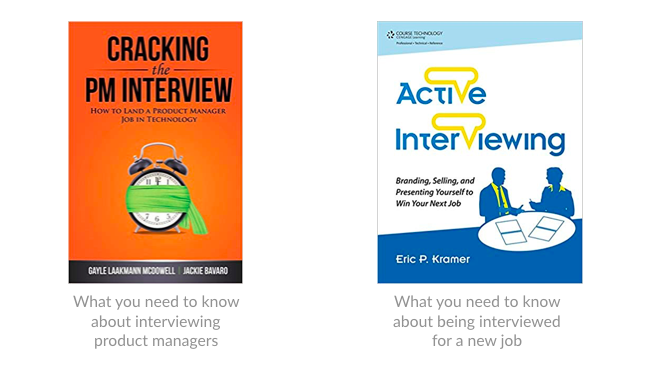 Here are two books that will significantly increase your abilities to manage a job interview.
Here are two books that will significantly increase your abilities to manage a job interview.
Active Interviewing: Branding, Selling, and Presenting Yourself to Win Your Next Job
Active Interviewing was a revelation for me. It reframed how I understood the process of interviewing and completely changed the way I prepared and went to an interview.
Why read this book: This book will change the way you show up in an interview and boost your chances of landing the job.
Get Active Interviewing here.
Cracking the PM Interview: How to Land a Product Manager Job in Technology
Cracking the PM Interview gives you a lot of advice on how to prepare yourself to answer questions the interviewers will ask you.
Why read this book: The way innovation consultants are interviewed is very close to the way product managers are interviewed.
Get Cracking the PM Interview here.
Insight into how consulting firms hire people and sell their services
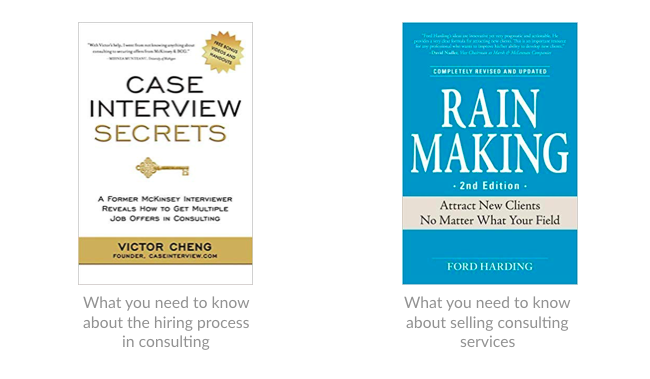 Many innovation consultancies are now part of larger networks owned by management consulting firms. It is important to understand how these companies are used to hire consultants and sell their services.
Many innovation consultancies are now part of larger networks owned by management consulting firms. It is important to understand how these companies are used to hire consultants and sell their services.
Case Interview Secrets
Case Interview Secrets digs into the many details on the hiring process and shares many simple frameworks for solving the infamous “consulting case studies”.
Why read this book: The standard way that a management consulting firm interviews applicants has inspired a lot of innovation consultancies. So, you should be fully aware of how it works.
Get Case Interview Secrets here.
Rain Making: Attract New Clients No Matter What Your Field
Rain Making dives into the many ways consultants can build their reputations and grow a network in order to sell their services.
Why read this book: This is a great read for the more senior people who want to get into innovation consulting, as they will be expected to sell projects.
Get Rain Making here.
Step 5: Read books about innovation and about job interviews to prepare yourself.
You can also do mock interviews with friends or classmates. There are companies that offer training. Note that some universities also offer coaching (via their career service or student societies).
6. Plan the questions you want to ask
An interview goes both ways: you’re as much interviewing them, as they are interviewing you.
Each innovation consulting firm is different. And so, you want to better understand what they value, how they work, whom they work for. Also, you may have questions about the recruitment process and the onboarding experience.
Here are some topics you may want to dive into:
- Their IP and methodology
- The industries they’re involved in
- The type of project they work on
- Their portfolio of clients
- The kind of people they hire
- The way they’re structured
- Their values and culture
Step 6: Do you research first. Prepare a list of questions based on what you couldn’t find online. Have a balance set of questions about the culture, the work, and the recruitment process (if anything is unclear to you).
Make sure to ask the questions in an informal. Don’t make it feel like you’re interviewing the interviewer. ;)
7. Wow the recruiters during the interview
Let me debunk a myth:
An interview is not about showing how smart and amazing you are. Actually, the more you are trying do to this, the more likely you will come across as pretentious or insecure.
Instead, be human and friendly. Make them feel like you’d be a great person to work with. You want them to think: “I’d enjoy working with this person”.
Step 7: Pay attention to how you come across when you meet new people in a professional context.
You may want to do mock interviews with people you don’t know, practice networking at an event, or take some improv classes. (The last option is a lot of fun, and I recommend it a lot!)
Interested in reading more?
Subscribe to my newsletter to get more content like this! :)
You can also support this type of content by having a look at my two books about innovation:
- The Value Mix will help you learn how to create new value propositions
- The Opportunity Lenses will tell you how to identify new business opportunities